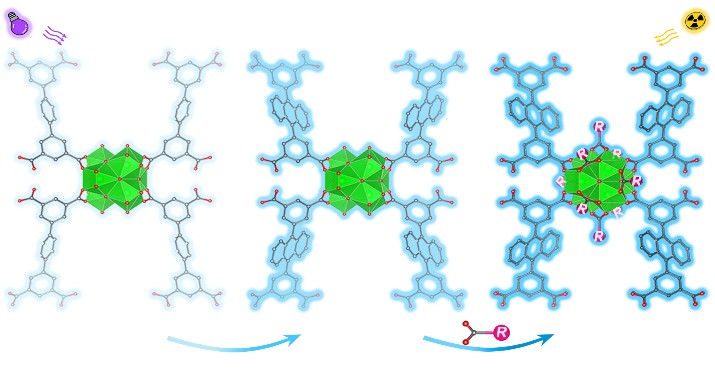Engineering the Unoccupied Electronic Levels in Nanoscale Zr-MOFs by Intrinsic Open-Metal-Site Modulation for Enhanced Luminescence
Editor: | Jun 19,2025
Scintillators are materials capable of converting high-energy particles or radiation into low-energy photons, playing a vital role in imaging fields such as healthcare, security, and industrial non-destructive inspection. Currently, commercial inorganic scintillators encounter challenges including low radiation stability, complex preparation processes, and poor processability. Therefore, developing novel high-performance scintillators to enhance X-ray detection capabilities is of decisive significance for ensuring public safety, improving medical diagnostic levels, and promoting high-end manufacturing development.
Metal-organic frameworks (MOFs), with their advantages such as strong structural designability, simple preparation, and excellent luminescent properties, are emerging as promising candidates for novel scintillators. Existing research shows that open metal site modulation strategies can effectively enhance the gas adsorption, catalysis, and chemical sensing performance of MOFs. However, research on enhancing photoluminescence and X-ray excited luminescence remains unexplored, hindering the practical application of MOFs in X-ray detection and imaging.
On this basis, the team from the Xinjiang Key Laboratory of Trace Chemical Substances Sensing at the Xinjiang Technical Institute of Physics and Chemistry has successfully synthesized Zr-ADIP nanocrystals featuring eight intrinsic open metal sites per Zr cluster by introducing a ligand containing isophthalic acid units. A strategy of utilizing modulators to occupy open metal sites was proposed to modulate the electronic levels of the MOF material and effectively enhancing its luminescence efficiency. The study found that benzoic acid-occupied Zr-ADIP-BzOH exhibited outstanding X-ray detection performance, with a detection limit as low as 0.53 μGy s⁻¹, which is 10 times lower than the minimum dose rate for medical X-ray imaging. Furthermore, leveraging the excellent X-ray excited luminescence of the obtained MOFs, an organic polymer composite scintillator film device was constructed. A series of rotational angle imaging of a clam sample enabled the non-destructive detection of its internal structure and the morphology of contained pearls. Overall, this study proposed intrinsic open site introduction and modulator modification strategy for enhancing the luminescence of MOFs, thus providing a new approach for the structural design and performance enhancement of novel scintillators.
This work was published in ACS Applied Nano Materials entitled as "Engineering the Unoccupied Electronic Levels in Nanoscale Zr-MOFs by Intrinsic Open-Metal-Site Modulation for Enhanced Luminescence". a joint master's student Jing Chen from Xinjiang Agricultural University is the first author, Prof. Baiyi Zu and Assistant Researcher Jiawen Li from Xinjiang Technical Institute of Physics and Chemistry and Associate Professor Huanhuan Wang from Xinjiang Agricultural University are the co-corresponding authors. This work is financially supported by the National Key Research and Development Program of China and National Natural Science Foundation of China.

Figure: Schematic representation of luminescence enhancement of MOFs based on ligand modulation and modulator modification strategy (Image by the Xinjiang Key Laboratory of Trace Chemical Substances Sensing)
附件下载:
 (86) 991-3838931
(86) 991-3838931 lhskj@ms.xjb.ac.cn
lhskj@ms.xjb.ac.cn (86)991-3838957
(86)991-3838957 40-1 Beijing Road
Urumqi, XinjiangChina
40-1 Beijing Road
Urumqi, XinjiangChina